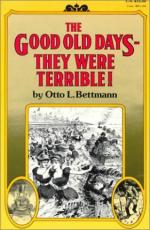
|
| Name: _________________________ | Period: ___________________ |
This test consists of 15 multiple choice questions and 5 short answer questions.
Multiple Choice Questions
1. In the late 1800s, why was street crime so rampant in the large cities at night?
(a) The were few alternatives to keep criminals off the streets.
(b) Streets were poorly lit.
(c) People were not careful and were easy targets.
(d) The police did not patrol at night.
2. The "protection" and "non-harassment" fees of the police in the late 19th century were a precursor to what later crime force?
(a) Mafia.
(b) Gangs.
(c) Street thugs.
(d) Drug lords.
3. Which part of the population got to enjoy the luxuries of ocean liners in the late 19th century?
(a) Politicians.
(b) Foreign dignitaries.
(c) The rich.
(d) Immigrants.
4. How was meat transported in the late 1800s?
(a) Packaged and delivered by the meat-packers.
(b) Live, on rail.
(c) Packaged in refrigerated rail cars.
(d) In refrigerated trucks.
5. What was "swill" milk?
(a) Milk from goats.
(b) Milk that had gone bad.
(c) Milk that was used for medicinal purposes.
(d) Milk from cows that were fed waste.
6. In 1890, how many prostitutes were estimated to be living in New York City?
(a) 40,000.
(b) 10,000.
(c) 5,000.
(d) 25,000.
7. What could the Pullman sleeping car in the late 19th century be compared to?
(a) Sleeping in a cattle car.
(b) The luxuries of an ocean liner.
(c) Sleeping in a sardine can.
(d) Sleeping standing up.
8. What was one problem with the police in the post Civil War era?
(a) The were poorly trained.
(b) They routinely ignored calls for help.
(c) They had no uniforms.
(d) They were too few in number.
9. According to Bettmann in "Food and Drink," the frontier diet was dominated by what single food?
(a) Beef.
(b) Pork.
(c) Corn.
(d) Wheat.
10. In the late 19th century, how did families deal with members who had mental illnesses?
(a) They drugged them.
(b) They took them for treatment.
(c) They had them sent away.
(d) They hid them.
11. What was Boss Tweed and Tammany Hall?
(a) A country-western song.
(b) Two famous New York cops.
(c) A corrupt political crime ring.
(d) An infamous night club known for illegal trafficking.
12. What was a huge problem for city schools in the post Civil War era?
(a) Overpopulation.
(b) Crime.
(c) Teacher turnover.
(d) Lack of funding.
13. How were medical advances defined during the Victorian period?
(a) They were considered a boom during this time.
(b) Medical breakthroughs were common.
(c) They did not keep pace with technological advances.
(d) Medical advances were few but very helpful.
14. Why did meat deteriorate so quickly in the late 1800s?
(a) It was injected with hormones.
(b) It was left to hang outdoors.
(c) The cows were poorly fed.
(d) It was injected with coloring dye.
15. What was a chief concern with train travel in the late 1800s?
(a) Being on schedule.
(b) Lost luggage.
(c) Overcrowding.
(d) Personal safety.
Short Answer Questions
1. What was the primary cause of surgical deaths after the Civil War?
2. Who ran the hospitals of the late 1800s?
3. The diet of the average American in the late 19th century was:
4. How could travel in the Victorian period be defined?
5. How did parents in the late 1800s react to teachers using necessary classroom discipline?
|
This section contains 518 words (approx. 2 pages at 300 words per page) |

|




